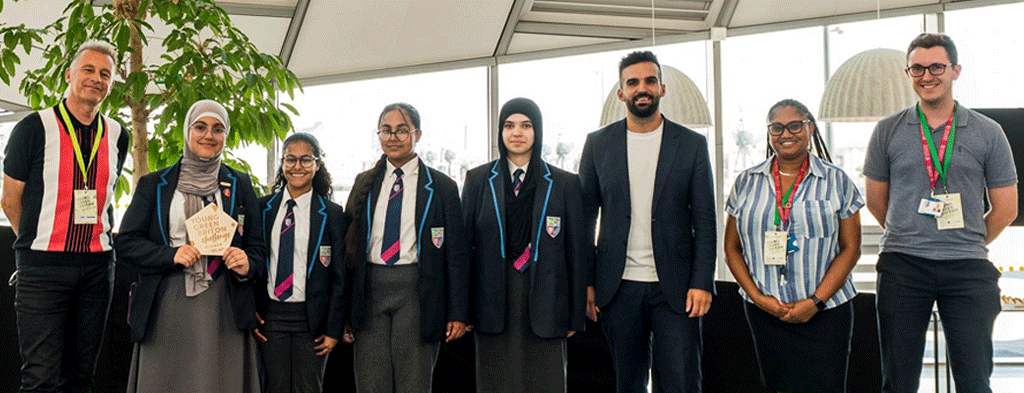Zero Carbon Luton - Issue 3, 2025
Luton's green football kit, an award winning school, and the council's scorecard
In this issue:
Luton Town with a sustainability first in football
Luton school wins a national eco award
Council Climate Action Scorecards
Contribute to Bedfordshire’s nature recovery strategy
Luton Town’s new green home shirt
No, the town haven’t risked the ire of fans and changed their home colours. But their new orange home kit may be the greenest football kit in the country.
This year's kit is made by Reflo, a sustainable sportswear company. It will use their Reloop fabric, which is made of recycled polyester and is in turn fully recyclable. It means the kit can be taken back and processed into new polyester at the end of its useful life.
The club say it's "a meaningful solution to the 92 million tonnes of textiles that end up in landfill each year, transforming shirts into a circular product that can be reborn season after season."
Reflo are signed up for three years, and are making the away and third kits too. All of them have been designed in collaboration with the Luton Supporter's Trust, ensuring that the material innovation still honours the club's tradition and branding.
This isn't just a first for Luton, it's a first for football. No other team has a shirt with environmental credentials like this one. Not even Forest Green Rovers, often hailed as the greenest team in the land. (Admittedly they may be about to unveil a new kit with Reflo too, but Luton have beaten them to the announcement and get to say they were the first.)
See also: why the Town’s new stadium will be among the greenest in the country.
Luton students win national eco award
A team of year 9 students from Chiltern Academy in Luton have won a national award in the Young Green Briton Challenge. The challenge presents students across the country with the facts about climate change and invites them to come up with solutions. Teams have to pitch their plans to their peers, and then a panel of experts, culminating in an event in London for the most promising ideas.
Winners chosen at the London event receive £1,000 in funding for their idea, and support to bring it to life. Chiltern’s winning team, Team Deforestation, won with a proposal to plant trees around the school and create a new school garden. They are pictured above with Chris Packham and London’s Deputy Mayor Mete Coban.
Chiltern’s new garden is on a previously neglected patch of the school grounds. It includes raised beds and a greenhouse, and is cared for by an after-school gardening club.
Your Climate Action Scorecard
Climate Emergency UK have released their latest Council Climate Action Scorecards, which aim to track council progress on their climate targets. Through an extensive survey, they measure action across a series of areas, including transport, buildings and heating, and planning and governance. This is the second time the scorecards have been compiled, which means that for the first time we can quantify local climate action across the UK.
So how’s Luton doing?
The good news is that the council’s score has gone up by 7 percentage points, showing an improvement on the 2023 score.
On a sector by sector basis, results are more mixed. There has been notable progress on homes, with new standards on rented properties and improvements to council homes. The council also scores well above the average on collaboration and engagement, thanks to the development and adoption of its climate plan.
However, these success stories are somewhat overshadowed by the scoring elsewhere, particularly on transport and finance. Luton gets penalty points awarded for air pollution, owning an airport and investing in high carbon projects (also the airport).
This is awkward for Luton. Most councils don’t happen to own an airport, which makes like-for-like comparisons difficult. Luton isn’t going to sell the airport, and it wouldn’t lead to lower emissions if it did, so the scorecards don’t reflect the complexities of climate action in the town.
Still, what the Council Climate Action Scorecards can do is give us a general sense of whether we are making progress. It provides some benchmarks for what good climate action looks like in towns of a similar size. And let’s hope for a further rise up the scoreboard next time.
The Nature Recovery Strategy
As part of government plans to improve the state of Britain’s wildlife and biodiversity, regions are being asked to draw up Local Nature Recovery Strategies. These documents will outline what is special about the natural landscape of the region, what is most at risk, and what the priority actions should be to protect and enhance nature.
Bedfordshire’s strategy is being led by Central Beds Council, but they need voices from Luton as part of the consultation process. What do you value most in the region, and what concerns you? Add your voice to the consultation to speak up for our orchards and woodlands, chalk hills and rivers - and don’t miss the consultation’s really useful map of the area’s habitats and biodiversity.
In other news…
Luton Repair Network delivered another round of succesful repairs at their June event at Hightown Community Centre. Look them up on Facebook for the next event, back in Hightown on the 25th of July.
Work on the new park and ride is due to begin this summer. Located at Butterfield, it will serve drivers coming into the town centre from Hitchin and Stevenage.
Five Luton parks have retained their Green Flag status: Brantwood Park, Peoples Park, Memorial Park, Stockwood Park and Wardown Park. The press release forgets to mention that there were six Green Flag parks last year, and Leagrave is the one missing from the list.
Speaking of Leagrave Park though, stick July 26th in your diary and pop down to Marsh House for the Luton Henge Festival, where a new landmark celebrating the chalk landscapes of the area will be unveiled.



